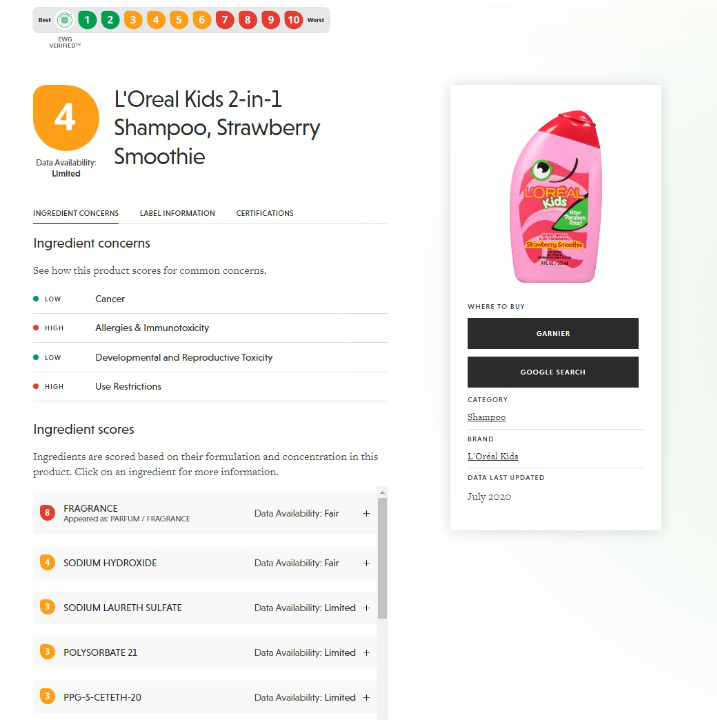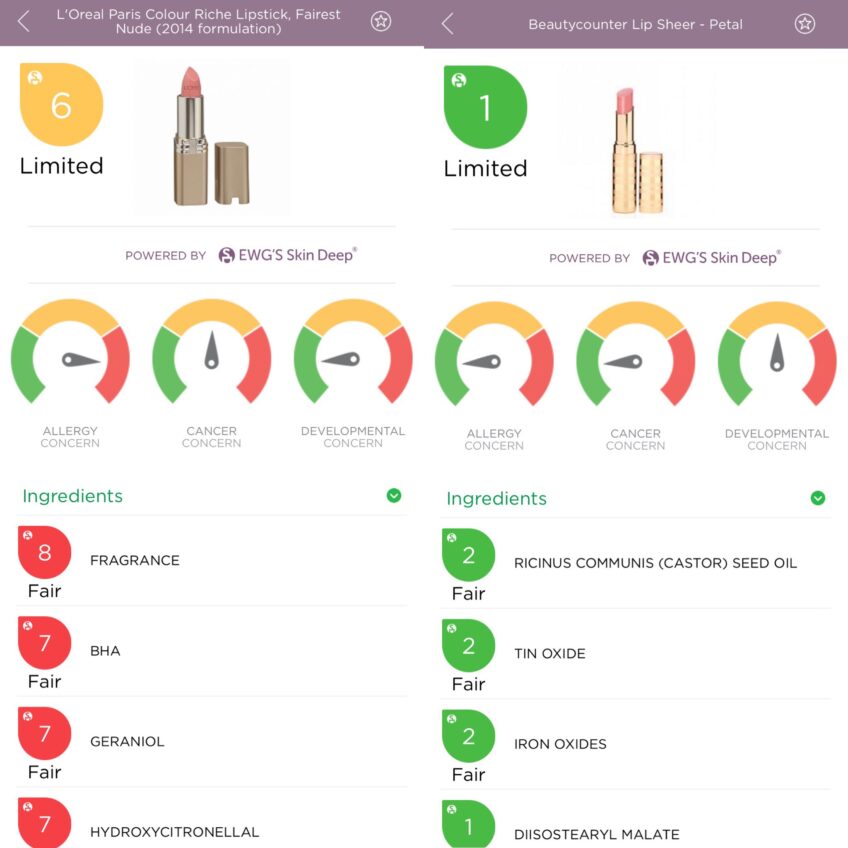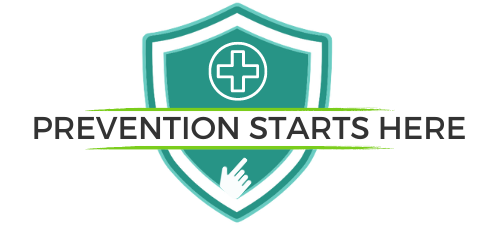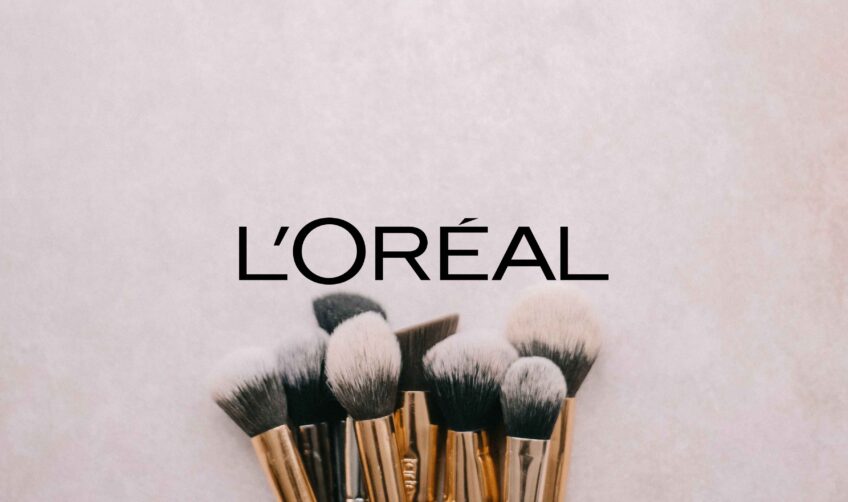Our Campaign for Safe Cosmetics found seven chemicals linked to cancer in L’Oreal products including benzophenone-1; titanium dioxide; and four formaldehyde-releasing preservatives.
In addition, the Campaign found four ingredients that were possibly contaminated with the known cancer-causing chemicals PFOA, acrylamide and asbestiform fibers.
The Campaign found these chemicals in: shampoos, nail polishes, eyeliners, mascaras, eye shadows, facial toners, BB cream, anti-aging products, blushes and powders.
Maybelline Great Lash mascara, one of L’Oreal’s most iconic products, which is easily identified by its pink and green packaging, lists the chemical Quarternium-15 on the label. Quaternium-15 releases carcinogenic formaldehyde, which is used to preserve mascara.

L’Oreal’s Kids 2-in-1 shampoo contained another formaldehyde-releasing chemical, DMDM hydantoin. Other companies, including Johnson & Johnson, have removed formaldehyde-releasing chemicals from children’s products.
The world’s largest cosmetics and beauty brand, L’Oreal is worth $14.5 billion. The company, with their motto “because I’m worth it,” feigns to value women, but has instead put the health and wellbeing of millions (?) of women at risk by using cancer-causing ingredients in products.
TAKE ACTION and tell L’Oreal that cancer isn’t glamorous.

Read on for our full letter to L’Oreal President and CEO Frédéric Rozé:
Dear Mr. Rozé,
I am writing on behalf of the Campaign for Safe Cosmetics, a national coalition of parents’, women’s, environmental health, nursing and consumer advocacy organizations working to protect the health of consumers, workers and the environment. while simultaneously fostering a vibrant, green economy that creates new opportunities for sustainable businesses. In the absence of health-protective laws to regulate the cosmetics industry, we are working with hundreds of forward-thinking cosmetics companies and more than 175 endorsing organizations to educate the public and shift the market toward safer personal care products.
Our ask of you is simple: The Campaign for Safe Cosmetics is requesting L’Oréal make a public commitment to eliminate carcinogens from its personal care and cosmetics products.
We created the Campaign for Safe Cosmetics 10 years ago to get chemicals linked to cancer, birth defects and other adverse health effects out of the cosmetics and personal care products that millions of consumers buy and use every day. Now, over a decade later, we were shocked by what we found: some of the biggest cosmetic companies – including yours – are still using chemicals linked to cancer by the world’s most-respected scientific authoritative bodies in a whole host of cosmetic and personal care products.
Over the summer and fall we consulted a number of digital cosmetic databases to research the presence of carcinogens in cosmetics and personal care products manufactured by the world’s largest multinational cosmetic companies and then verified our findings by reading actual product labels.
Our investigation of L’Oréal products revealed the use of chemicals linked to cancer in its eye makeup. We also found cancer-causing chemicals in anti-aging creams, nail polish and hair products made by your most iconic brands Maybelline and Garnier.
Your kids’ products are not free of cancer-causing chemicals either. The Campaign found contains DMDM hydantoin in L’Oréal Kids 2-in-1 shampoos, a chemical that releases formaldehyde to preserve the product.
As you may know, formaldehyde has been designated as a carcinogen by many authoritative, scientific bodies, including the United States National Toxicology Program and the International Agency for Research on Cancer. Companies like Johnson & Johnson have already removed formaldehyde-releasing chemicals from its children’s products proving you could and should be as well.
The Campaign for Safe Cosmetics found these chemicals linked to cancer in a number of L’Oréal products on store shelves:
- Benzophenone-1 in L’Oreal Colour Riche and Maybelline Color Show nail polishes;
- Carbon black in L’Oreal eyeliner
- Titanium dioxide (in inhalable form) in L’Oreal eye shadows and Maybelline blushes and pressed powders
- Formaldehyde releasing preservatives
- DMDM hydantoin in L’Oreal Kids shampoos
- Imidazolidinyl urea in L’Oreal mascaras, eye shadows, and both L’Oreal and Maybelline brand eyeliners
- Diazolidinyl urea in facial toner, BB cream
- Quaternium-15 in Maybelline Great Lash mascaras
In addition, we found four ingredients that are possibly contaminated with carcinogens:
- Polytetrafluoroethylene (PTFE) which can be contaminated with PFOA in L’Oreal eye shadows and Garnier anti-aging products; and
- Polyperfluoromethylisopropyl ether which can be contaminated with PFOA in L’Oreal eye shadows
- Polyacrylamide which can be contaminated with acrylamide in Garnier anti-aging products
- Talc (in inhalable form) which can be contaminated with asbestiform fibers in L’Oreal eye shadows and Maybelline blushes and pressed powders
For decades, L’Oreal has used the tagline “Because I’m worth it.” Even according to your website, this phrase epitomizes your brand by focusing on women: “It was about her self-confidence, her decision, her style.” Today, you can show us you believe we’re truly worth it by eliminating cancer chemicals from your cosmetic products.
We think the best way to prioritize women’s health is to stop using chemicals linked to cancer in cosmetics. Ending our daily exposure to chemicals linked to cancer in shampoos, lotions, and makeup is a critically important step that L’Oréal can take today to help prevent cancer.
More and more scientific evidence is linking breast cancer to the chemicals in our everyday environment—chemicals in our cosmetics and personal care products, our household cleaning products, our food, our air and our water.
Increasingly, consumers are looking to the Campaign for Safe Cosmetics, third-party certifiers and manufacturers to ensure that cosmetics and personal care products are safe. According to industry analysts, natural and organic cosmetics are now becoming the “second mainstream” and represent the fastest-growing segment of the cosmetics industry, even during the recession—a trend due in large part to growing consumer concerns about toxic chemicals in cosmetics. Customers and shareholders alike are asking for safer products and an increasing number of shareholder resolutions on environmental health and toxic chemicals make it clear that safety and transparency are good for a company’s reputation and good for business.
To respond to these demands and to remain competitive, forward-thinking companies—both manufacturers and retailers like Target and Walmart —are adopting safe cosmetics chemical use policies, including chemical screens for a wide range of products, and incentives for safer products.
L’Oréal, which sells thousands of cosmetic products to consumers daily, has built its reputation on its ability to provide high-quality, effective, safe products. In the absence of adequate safety guidelines from the FDA, we hope that you will take action consistent with your corporate reputation and go beyond regulatory compliance, rising to the highest level of safety set by other companies and the international community. We believe that by doing so, you will protect public health, reduce pollution in our environment and ensure your position as a market leader.
Truly, the best way for L’Oréal to prioritize women’s health is to stop using chemicals linked to cancer in its cosmetics!
Please contact me so that we may discuss your company’s cosmetics safety policy. We look forward to working with you, and we hope to be able to highlight L’Oréal as a true industry leader.
Please write back and let me know how you plan to address our important concerns.

